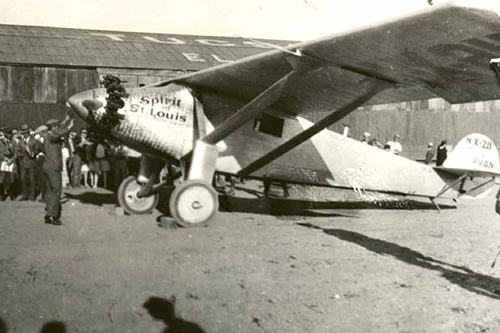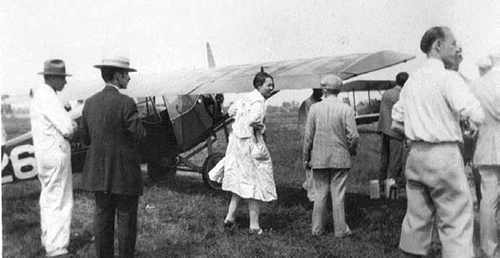
MODERN CONNECTIONS TO THE GOLDEN AGE OF AVIATION


Story One
Between 1996 and 2002, I was the director of a small museum at the Portal of the Folded Wings, in North Hollywood, CA, near the edge of Bob Hope Airport. Under the dome of the 100-foot-tall decorative monument, there were 14 graves of famous American pioneers in aviation, yet only 13 had proper bronze tablets to commemorate their life achievements. The fourteenth space was eerily empty, and after I retrieved the 1950s cemetery records, I discovered why. Aviator James Crawford “Jimmy” Angel [1899-1956] had originally been destined to lie among his peers at the Portal, but his family decided to honor Angel’s request and spread his ashes over the waterfall that now bears his name. (Yes, that would be Angel Falls.) On Oct. 9, 1937, Angel landed his monoplane in the jungle and reported the sight of the world’s highest waterfall at Auyantepui, Venezuela. As I led Portal tours, I enjoyed pointing to the ghostly imprint of an empty grave and telling what little I knew of Angel’s story. I was often asked what happened to Angel’s bronze tablet. It was unsettling, but despite my search, I had no answer.
Story Two
Four years later, I had moved to Arizona. In order to learn more about J. Parker Van Zandt [1894-1990,] the founder of the first air tours over the Grand Canyon in the late 1920s, I searched the Internet and found the Web site of the Davis-Monthan (D-M) Aviation Field Register. The register recorded landings and take offs at Tucson, AZ, between 1925 and 1936. On the Web page for Van Zandt, I found 10 landing dates (1927-1928) when he carried passengers in his Stinson aircraft to Phoenix, Tucson, and Nogales, AZ; El Paso, TX, and Los Angeles. The statistics came alive for me when I saw Van Zandt’s signature in the register, and followed all of the online links to further photographs, documents and personal stories added by the Web site’s creator, Gary Hyatt. I felt like Alice in Wonderland who fell down a rabbit hole. I wandered into unknown, delightful, exciting and unexplored paths without knowing my final destination.
The D-M register has 3,704 listings, originally hand-written within the leather-bound book which Hyatt purchased in 2000. By 2001, he had created the D-M database.
“After I created the data base,” explained Hyatt, “I could focus on specifics and discovered that 42 female pilots made 56 landings and that nine of their aircraft are still registered with the FAA. A sort by aircraft showed 233 landings during two years were made by Standard Air Lines in Fokker planes on their round-trip routes among Los Angeles to Phoenix, Tucson, and Douglas, AZ, and El Paso, TX.” By 2005, Hyatt had his data base artistically rendered into a Web site. Visitors can now use pull-down menus to look at the original register or find people, places, airplanes and events.
I still like to turn paper pages, so I bought Hyatt’s companion book which reproduced each hand-written page of the register, as well as queries from his database. I love the index. Just for fun and among the dozens of familiar names of pilots and aircraft, I quickly found three landings between 1930 and 1931 by Amelia Earhart, two by “Hap” Arnold (March 17, 1930, and Aug. 23, 1933), and one each by Pancho Barnes (Feb. 25, 1930) and Charles Lindbergh (Sept. 23, 1927).

Story Three
I was already in awe of Hyatt when in this past June I received a press release announcing that he has acquired the registers for five more airfields in the U.S. and built Web sites similar to D-M. The new registers are from Clover Field, Santa Monica, CA; Grand Central Air Terminal, Glendale, CA; Parks Field, East St. Louis, IL; Peterson Field, Colorado Springs, CO; and Pitcairn Field, Willow Grove, PA. It is now possible to roam across the U.S. and trace flights and pilots over a span of 21,667 air traffic days between 1925 and 1942. The interconnection among the registers is like a tangled vine with endless new sprouts as visitors to the Web sites add information.
I asked Hyatt for an example of a crossover of data among the new airfields and he gave me several. “I haven’t completely finished the data base for Grand Central Air Terminal,” said Hyatt, “but so far I’ve discovered many pilots landed at two or more of these fields. Jimmy Angel landed at three out of six.” That caught my attention, so I visited the pages hosted by Hyatt to see what more had been learned since I had given tours at Angel’s Portal grave site in 2002.
The Registers Connect Story One with Story Three
I began with Hyatt’s Clover Field listing when Angel arrived from Long Beach, CA, on Sept. 18, 1929, and departed back to Long Beach at a date and time unrecorded. I learned that he flew a Zenith Albatross, tail number NX3622, and that he carried six passengers. I took a quick peek at Angel’s original penned entry in the log book, and went back to find more biographical information. A brief biography and photograph of Angel led me one click away to a larger biographical page complete with a copy of his 1938 (renewed) pilot’s license, a 1927 newspaper article describing his search for gold in Mexico, and a link to the “Jimmy Angel Historical Project” Web site, founded by Angel’s niece.
The myths and facts of Angel’s life are mingled together and some of it will never be sorted out. One story Angel often told was that he had been hired for $5,000 by a treasure seeker he met in a South American bar during 1920 to fly into a remote river area where he could retrieve bags of gold. It was during that trip, according to family legends, that Angel first learned of a giant waterfall. It also led to a life-long quest to find the “river of gold” which he claimed had yielded treasures. Seventeen years later, accompanied by his wife, Mary, and a few fellow adventurers, Angel landed his Flamingo aircraft close to the waterfall. The landing damaged the plane and the party had to abandon it, but Angel left a note written in English (later discovered) that they were unharmed and hiking out to safety. Whether Angel had been the first to see the giant falls is unknown, but he is credited with initiating international interest in the new geographical discovery. During 1970, Angel’s Flamingo was recovered and it is now on display outside a Venezuelan airport.

I learned that in addition to Clover Field, Angel landed at Davis-Monthan (on April 10, 1930, during a flight from Los Angeles to New York) and at Peterson Field (on Sept. 17, 1932, during a flight from Kansas City, MO, to Los Angeles). Angel died in Panama City on Dec. 8, 1956, and was initially interned at the Portal. “But in keeping with his wishes,” states Wikipedia, “his wife, two sons and two of his friends scattered his ashes over Angel Falls on July 2, 1960.” Again I wondered what became of Angel’s original bronze tablet.
I asked a friend to take a photograph of Angel’s empty grave at the Portal but, unfortunately, the cemetery’s view of history has changed, and the spot has been resold. Nevertheless, I was happy to find through the register’s Web site, a photograph of a bronze tablet honoring Angel in the Canaima National Forest in Venezuela. It is not the original tablet from California, but now, thanks to the modern connections among historians like Hyatt, both Angel and I can rest peacefully.
Giacinta Bradley Koontz is an aviation historian, magazine columnist and author who has received the DAR History Medal and Honorable Mention from the New York Book Festival. She has appeared on the History Channel and in PBS documentaries. For more information, visit www.GiaBKoontz.com.
Warning! Enter these Web sites at the risk of losing track of time.
Clover Field, Santa Monica, CA - www.cloverfield.org
Davis-Monthan Aviation Field, Tucson, AZ - www.dmairfield.org
Grand Central Air Terminal, Glendale, CA - www.grandcentralairterminal.org
Parks Field, East St. Louis, IL - www.parksfield.org
Peterson Field, Colorado Springs, CO - www.petersonfield.org
Pitcairn Field, Willow Grove, PA - www.pitcairnfield.org
Be sure to read “What You Can Expect” on the home page of www.dmairfield.com
